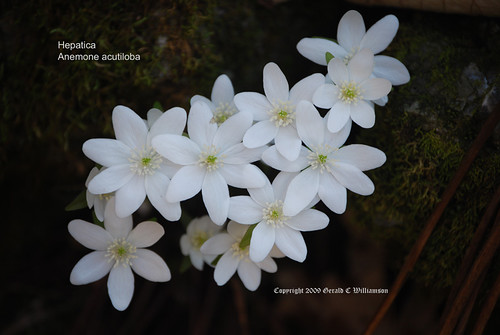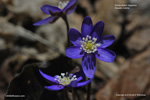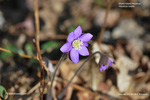My Twitter friend OurLittleAcre tweeted for an assist in a species identification on a Hepatica photo a day or so ago. As we tweeted back and forth a few times about the species and color variation, it became clear that the subject was going to be difficult to discuss in 140-character messages, and since I wanted to record my thoughts and what I was learning as I researched the subjects, a post here on the USWildflowers Journal seemed to be in order.
Hepatica has previously been classified in the Anemone genus, but was reclassified into its own genus, Hepatica. It appears that there were several Hepatica species, but I haven’t taken the time to do any research beyond H. acutiloba – Sharplobe Hepatica (at one time it apparently known as H. acuta), and H. americana – Roundlobe Hepatica (apparently know as H. hepatica until sometime in the 20th century.) The difference is primarily in the shape of the 3 lobes of the deeply-cut basal leaves, although the sepals of the blossom apparently also follow the leave tip pattern to an extent – pointed in H. acutiloba, and rounded in H. americana.
Classification to the species is now easier. All species in the Hepatica genus have recently been rolled into a single species – Hepatica nobilis. This change is recent enough that most publications, including the one book that I use more than any other – Wildflowers Of Tennessee, The Ohio Valley and the Southern Appalachians, continue to list them as separate species. There are now two recognized varieties, with Hepatica nobilis Schreb. var. acuta being Sharplobe Hepatica, and Hepatica nobilis Schreb. var. obtusa being Roundlobe Hepatica. If you were able to determine the prior species separation, you’ve now got the variety classification. I think I liked it better as separate species, but folks smarter than me are making those decisions.
So how does the color of the blossom come into the determination as to which variety we have? It doesn’t seem to be a factor in classification, although I have seen some descriptions that imply fewer color variations in Roundlobe Hepatica than in Sharplobe Hepatica.
Hepatica comes in a wide range of colors. A pure white is the most common, and it is really beautiful showing up against the brown leaves on the forest floor. But it can also
be in a range of colors from pale pink thru lavender to deep purple and blue. I’ve read and heard some speculation on the causes of the color variation, most of which have centered on soil acidity, but the conclusions of those discussions have been “we don’t really know.” I do know that you may find a deep purple or blue hepatica within a foot of a white hepatica, although I’ve never found color variation on the same plant.
One other point of discussion with OurLittleAcre – will a plant vary in color from season to season? I don’t recall any discussion that I’ve seen or heard on that point, and I haven’t kept track of my own observation. However, I do know that there are
some specific spots where I’ve seen blue Hepatica season after season for at least two or three years, so my guess is that a particular plant will stay the same color. But that’s just a guess, and as a result of this discussion, I’ll try to be a bit more observant about specific plants to see if over the years a plant could change on us. Feedback and other observations are welcome.




Gerri, thank you for posting this! I love knowing about the wildflowers. Getting ready to go out to the woods this weekend to see what we can see. It’s one of my favorite things about April and May. 🙂
My post, linking to this one of yours, will publish tomorrow! 🙂
Thanks, Kylee! I just wish I had more time to “dive deeper” on more of the plants. This wildflower hobby is gratifying at many levels. I sure appreciate the mention, and love your hepatica photos over at OurLittleAcre.
I saw, today, an area covered with several patches of hepatica. It was all round lobed, and the colors varied from white to pink to lavender. All within a stone’s throw of one another, and not all grouped together by color. Initially we wondered whether the pink was hepatica, but when we looked more closely, it clearly was. This was in Western MA, in late April.